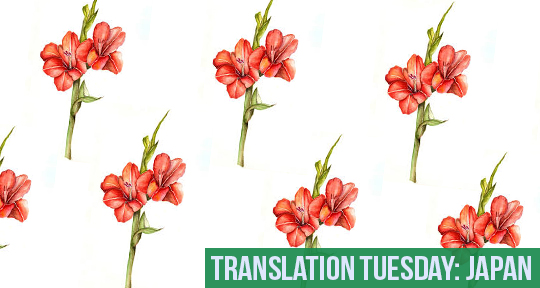This week for Translation Tuesday, Asymptote is pleased to present the lush poem “Gold Dust’s Sleep (Seven Fragments).” These fragments from Japanese luminary Yonezawa Nobuko revel in the fusion of concept and image in miniature. Inspired by the Symbolist tradition, Yonezawa’s poetry seems to refract the very words that make it up, allowing for subjective particulates to surface from the flow of experience and conspire with the reader. In this skillful translation, the concrete style of the original is maintained, so that the form of the stanzas themselves seem to impress a visual coherence and solidity to the movement of the language. As if struck with an afterthought, the poems end with suspended lines that evoke a response and an elaboration. With movement and the quotidian electrified, they breathe.
Gold Dust’s Sleep (Seven Fragments)
I
That moment, like the blind,
running
at full speed,
gently
gold dust was sleeping
the simple,
faded color of dreams.
II
Bare reality,
just a flower planted in a beaker.
Spotted as if with falling blood,
raw
gladiolus.
III
The light, spilling hair,
in the distance
plays on a good face.
Today was yet another day,
drunkenly
smiling as it passed on.
IV
As I fell asleep,
oh,
my child was born.
Grass
has covered the earth,
faintly
filled it with a smell.
V
Shall we sing,
birds and fish,
or perhaps
every heart’s bright thing.
A path,
linear,
flat and white.
VI
That line of trees
through intense heat
must come to an end somewhere.
Beneath them, oh living things,
wander
as you dance.
VII
Some day,
that ever lovely shining ring
traced in the sky
suddenly
will be a somewhere I have set foot.
Ah,
sleeping gold dust wakes,
and then—.
Translated from the Japanese By Marianne Tarcov
Yonezawa Nobuko was born in Tokyo in 1894. Her poetry collection Holy Fount, self-published in November 1919, created a small sensation in the Japanese literary world with its combination of classical Japanese language and innovative new Symbolist poetic techniques, such as synesthesia. She studied both Japanese and Western painting, and has a strong visual sense in her poetry. Her poetry often features passionate emotion, women in intense couples or pairs, and lush floral imagery. Her work shows the clear influence of early shōjo, or girls’ culture, a movement in Japanese popular culture that portrays girlhood as a liminal space outside the boundaries of hegemonic gender roles. Her collected works were published posthumously by her husband Yonezawa Masatami after her premature death from tuberculosis in 1931.
Marianne Tarcov is a translator and visiting professor of East Asian Languages and Cultures at the University of Notre Dame in South Bend, Indiana. She is working on a book project about the politics of twentieth-century Japanese lyric poetry. Her research interests include modern Japanese poetry, film, popular culture, professional wrestling, and more.
*****
Read more translations from the Asymptote blog:

